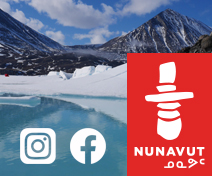Nunavut

Canada’s True North
By Margo Pfeiff
Experience the spirit of the Arctic, a wild and dramatic landscape of glaciers, treeless tundra, mountains and oceans that remain frozen most of the year. Visit remote towns and meet local Inuit who make up 84 percent of the population of Nunavut, “our land” in Inuktitut, and experience their culture in this unique and little-known territory—Canada’s newest.
The size of Western Europe, Nunavut
is the biggest and least populated of Canada’s provinces and territories, 2,093,190 sq. km (808,185 sq. mi.). Covering one-fifth of the country’s total area, reaching almost to the North Pole, the population could fit into an average sports stadium 52.7 sq. km (19.44 sq. mi.).
Traditions Live On
While Nunavut’s capital of Iqaluit is a modern town with a population of 9,752, the 25 other communities scattered across the territory are much smaller, some home to just a few hundred residents. No roads link Nunavut’s communities, nor are there roads connecting Nunavut to the rest of Canada.
In the remote hamlets, life is often still guided by age-old timetables and traditions. Though snowmobiles, boats and guns have largely replaced dogsleds, kayaks and harpoons, many Inuit continue to hunt and fish to support their extended families. Going out “on the land,” camping throughout summer, collecting bird eggs and picking berries are all traditions still carried out. Women wear homemade amauti jackets that keep their babies tucked against their backs.
Drum dancing, throat singing, carving, storytelling and sewing traditional clothes are still practiced throughout Nunavut and locals are happy to share the experiences.
Out On The Land
While the communities are cultural outposts, most visitors also want to experience the mystical Arctic wilderness with its dramatic scenery and wealth of wildlife. Always choose licenced and insured operators. Reservations are required with many operators as most trips are booked well in advance.
An increasingly popular way to explore Canada’s Arctic is via cruise ships that hopscotch along the coast, stopping at several communities where guests are welcomed with performances, feasts and handmade artwork and souvenirs. Often, Inuit elders, artists and cultural experts will travel on-board to enhance the experience.
Extreme Territory
Temperatures range from +30°C (86°F) in summer to -50°C (-58°F) in winter when much of the territory lies in almost 24-hour darkness as skies shimmer with the magical colours of the aurora borealis. So most visitors come during the short summers, when pleasantly cool days are lit around the clock by the midnight sun and the tundra comes to life with wildflowers and wildlife and the waters teem with whales, walrus and seals.
What’s New?
Tallurutiup Imanga National Marine Conservation Area, an area rich in biodiversity, was established north of Baffin Island. At approximately 108,000 square kilometres (41,699 sq. mi.), this breathtaking Arctic landscape, where narwhals and thousands of seabirds reside, is rich with majestic fjords and glaciers (www.pc.gc.ca/en/amnc-nmca/cnamnc-cnnmca/tallurutiup-imanga).
Anu Outfitters, a proudly Inuk-owned company is set to share the soul of the Arctic, whether tracking polar bears near frozen fjords or listening to local guides share traditional knowledge beside a crackling fire. The new immersive tour company is based in Igloolik.
City Lights
Nunavut’s capital of Iqaluit can easily be strolled on foot. Visit the igloo-shaped Anglican church and the Nunatta Sunakkutaangit Museum with its Inuit artefacts, as well as carvings and prints for purchase in the gift shop. The Unikkaarvik Visitor Centre features wildlife and cultural exhibits, while the Nunavut Legislative Assembly building displays temporary art shows alongside their permanent northern art collection including the Legislative Mace carved from a narwhal tusk. Check the Iqaluit Visitors Guide for local events and places to stay, eat and shop (www.iqaluit.ca/visitors).
The Great Outdoors
Nunavut has five national parks, 15 territorial parks and special places, four Canadian Heritage Rivers, as well as 11 migratory bird sanctuaries and wildlife reserves. But in reality, Arctic wilderness starts on the doorstep of every hamlet.
From June through September there is hiking, kayaking, whitewater rafting and marine mammal watching for narwhal, bowhead and beluga whales as well as walrus, seals and polar bears. Many of these activities can be experienced on day trips from communities. Sport fishing is popular, with fishing lodges and camps accessible by boat and float planes. In winter, there is ice fishing and travelling across the frozen tundra and sea ice by snowmobile, on cross-country skis and via dogsled. Choose a hamlet hotel base, camp on the tundra with an outfitter, or enjoy the comfort of luxury wilderness lodges including Arctic Watch and Bathurst Inlet Lodge (www.weberarctic.com; www.bathurstarctic.com).
More adventurous travellers can canoe the Soper River in Katannilik Territorial Park on Southern Baffin Island or the Thelon River on the Barren Lands. Rock climb granite peaks in Auyuittuq National Park, backcountry ski amid Clyde River’s sheer rock walls, or paddle Alexandra Fjord and hike in Quttinirpaaq National Park on Ellesmere Island (www.blackfeather.com).
Heritage And Culture
Throughout Nunavut are sites once used by nomadic Inuit. Stone rings marking the locations of skin tents used in summers are commonly spotted. In Qaummaarviit Territorial Park, near Iqaluit, semi-subterranean sod houses used by Thule people between 1200 and 1700 AD can be seen (www.nunavutparks.com/nunavut_parks/qaummaarviit-territorial-park).
There are also many Hudson’s Bay Company trading posts, remnants from the 19th century whaling era and, on Beechey Island, the graves of three men from Sir John Franklin’s search for the Northwest Passage. The Northwest Passage can be explored on expedition cruises staffed
with artists, academics and Inuit (www.quarkexpeditions.com/en/arctic; www.adventurecanada.com).
Carving is common throughout Nunavut, but Cape Dorset is the epicentre of iconic Inuit sculptures that have been gifted to presidents, popes and royalty (www.dorsetfinearts.com). Their print-making is also acclaimed. The Kenojuak Cultural Centre, an art studio and exhibition space, covers seven decades of printmaking. The print centre in Pangnirtung is also world-renowned (www.uqqurmiut.ca).
Must See, Must Do
Dogsled or kayak on a day trip out of Iqaluit (www.inukpakoutfitting.ca).
Experience an Arctic safari aboard a snowmobile-drawn Inuit sled from coastal Pond Inlet to the floe edge in springtime, guided by Inuit. Wildlife, from whales to polar bears, take part in an open water feeding frenzy (www.arctickingdom.com/arctic-safari).
Watch polar bears and walrus emerge from stone, antler and whalebone as carvers work outside their homes in most hamlets.
See colourful northern lights flicker across the sky in fall and winter.
Experience Inuit throat singing and drum dancing (www.alianait.ca).
Squeeze yourself into the tiny but busy South Baffin Holdings, an art shop chocka-block with carvings, prints and parkas.
Schedule a visit to Uasau Soap, where you can get your hands on body butter, soaps and other skin care products sourced from traditional ingredients such as seal oil, whale and seaweed.
If you’re lucky enough, taste traditional Inuit food like Arctic char, caribou, muskox—not a regular menu item, and fresh, hot bannock bread.
Scenic Walks
Experienced backpackers can traverse the 97-km (60-mi.) Akshayuk Pass through Auyuittuq National Park, a 10 to 14-day hike amid glaciers, sheer cliffs and river crossings. Be sure to travel with one of the licenced, insured and Park-approved outfitters in Pangnirtung and Qikiqtarjuaq. The less adventurous can glimpse the pass’ spectacular mountain terrain on a day’s boat ride up the fjord from Pangnirtung to hike to the Arctic Circle (www.parkscanada.gc.ca/auyuittuq).
Hike the trail up the peak of 200-m (656-ft.) Mount Pelly in Ovayok Territorial Park east of Cambridge Bay for views, wildflowers and archaeological sites (www.nunavutparks.com/parks-special-places/ovayok-territorial-park).
Stroll easy paths through a tundra valley to waterfalls and cultural sites at Sylvia Grinnell Territorial Park just outside Iqaluit (www.nunavutparks.com/parks-special-places/sylvia-grinnell-territorial-park).
Family Fun
Head to Iqaluit from Ottawa on a family-friendly long weekend in August. Flights, hotel and a town tour are included (www.arctickingdom.com/arctic-getaways).
Take the kids to play with Canadian purebred Inuit dog puppies at Inukpak Outfitting’s kennel, head out for a dogsledding excursion, build an igloo with your family then sleep in it, or ride a snowmobile and try ice fishing (www.inukpakoutfitting.ca).





